How to Write a Bibliography for a Research Paper

Do not try to “wow” your instructor with a long bibliography when your instructor requests only a works cited page. It is tempting, after doing a lot of work to research a paper, to try to include summaries on each source as you write your paper so that your instructor appreciates how much work you did. That is a trap you want to avoid. MLA style, the one that is most commonly followed in high schools and university writing courses, dictates that you include only the works you actually cited in your paper—not all those that you used.

Academic Writing, Editing, Proofreading, And Problem Solving Services
Get 10% off with 24start discount code, assembling bibliographies and works cited.
- If your assignment calls for a bibliography, list all the sources you consulted in your research.
- If your assignment calls for a works cited or references page, include only the sources you quote, summarize, paraphrase, or mention in your paper.
- If your works cited page includes a source that you did not cite in your paper, delete it.
- All in-text citations that you used at the end of quotations, summaries, and paraphrases to credit others for their ideas,words, and work must be accompanied by a cited reference in the bibliography or works cited. These references must include specific information about the source so that your readers can identify precisely where the information came from.The citation entries on a works cited page typically include the author’s name, the name of the article, the name of the publication, the name of the publisher (for books), where it was published (for books), and when it was published.
The good news is that you do not have to memorize all the many ways the works cited entries should be written. Numerous helpful style guides are available to show you the information that should be included, in what order it should appear, and how to format it. The format often differs according to the style guide you are using. The Modern Language Association (MLA) follows a particular style that is a bit different from APA (American Psychological Association) style, and both are somewhat different from the Chicago Manual of Style (CMS). Always ask your teacher which style you should use.
A bibliography usually appears at the end of a paper on its own separate page. All bibliography entries—books, periodicals, Web sites, and nontext sources such radio broadcasts—are listed together in alphabetical order. Books and articles are alphabetized by the author’s last name.
Most teachers suggest that you follow a standard style for listing different types of sources. If your teacher asks you to use a different form, however, follow his or her instructions. Take pride in your bibliography. It represents some of the most important work you’ve done for your research paper—and using proper form shows that you are a serious and careful researcher.
Bibliography Entry for a Book
A bibliography entry for a book begins with the author’s name, which is written in this order: last name, comma, first name, period. After the author’s name comes the title of the book. If you are handwriting your bibliography, underline each title. If you are working on a computer, put the book title in italicized type. Be sure to capitalize the words in the title correctly, exactly as they are written in the book itself. Following the title is the city where the book was published, followed by a colon, the name of the publisher, a comma, the date published, and a period. Here is an example:
Format : Author’s last name, first name. Book Title. Place of publication: publisher, date of publication.
- A book with one author : Hartz, Paula. Abortion: A Doctor’s Perspective, a Woman’s Dilemma . New York: Donald I. Fine, Inc., 1992.
- A book with two or more authors : Landis, Jean M. and Rita J. Simon. Intelligence: Nature or Nurture? New York: HarperCollins, 1998.
Bibliography Entry for a Periodical
A bibliography entry for a periodical differs slightly in form from a bibliography entry for a book. For a magazine article, start with the author’s last name first, followed by a comma, then the first name and a period. Next, write the title of the article in quotation marks, and include a period (or other closing punctuation) inside the closing quotation mark. The title of the magazine is next, underlined or in italic type, depending on whether you are handwriting or using a computer, followed by a period. The date and year, followed by a colon and the pages on which the article appeared, come last. Here is an example:
Format: Author’s last name, first name. “Title of the Article.” Magazine. Month and year of publication: page numbers.
- Article in a monthly magazine : Crowley, J.E.,T.E. Levitan and R.P. Quinn.“Seven Deadly Half-Truths About Women.” Psychology Today March 1978: 94–106.
- Article in a weekly magazine : Schwartz, Felice N.“Management,Women, and the New Facts of Life.” Newsweek 20 July 2006: 21–22.
- Signed newspaper article : Ferraro, Susan. “In-law and Order: Finding Relative Calm.” The Daily News 30 June 1998: 73.
- Unsigned newspaper article : “Beanie Babies May Be a Rotten Nest Egg.” Chicago Tribune 21 June 2004: 12.
Bibliography Entry for a Web Site
For sources such as Web sites include the information a reader needs to find the source or to know where and when you found it. Always begin with the last name of the author, broadcaster, person you interviewed, and so on. Here is an example of a bibliography for a Web site:
Format : Author.“Document Title.” Publication or Web site title. Date of publication. Date of access.
Example : Dodman, Dr. Nicholas. “Dog-Human Communication.” Pet Place . 10 November 2006. 23 January 2014 < http://www.petplace.com/dogs/dog-human-communication-2/page1.aspx >
After completing the bibliography you can breathe a huge sigh of relief and pat yourself on the back. You probably plan to turn in your work in printed or handwritten form, but you also may be making an oral presentation. However you plan to present your paper, do your best to show it in its best light. You’ve put a great deal of work and thought into this assignment, so you want your paper to look and sound its best. You’ve completed your research paper!
Back to How To Write A Research Paper .
ORDER HIGH QUALITY CUSTOM PAPER

Educational resources and simple solutions for your research journey

A Beginner’s Guide to Citations, References and Bibliography in Research Papers

As an academician, terms such as citations, references and bibliography might be a part of almost every work-related conversation in your daily life. However, many researchers, especially during the early stages of their academic career, may find it hard to differentiate between citations, references and bibliography in research papers and often find it confusing to implement their usage. If you are amongst them, this article will provide you with some respite. Let us start by first understanding the individual terms better.
Citation in research papers: A citation appears in the main text of the paper. It is a way of giving credit to the information that you have specifically mentioned in your research paper by leading the reader to the original source of information. You will need to use citation in research papers whenever you are using information to elaborate a particular concept in the paper, either in the introduction or discussion sections or as a way to support your research findings in the results section.
Reference in research papers: A reference is a detailed description of the source of information that you want to give credit to via a citation. The references in research papers are usually in the form of a list at the end of the paper. The essential difference between citations and references is that citations lead a reader to the source of information, while references provide the reader with detailed information regarding that particular source.
Bibliography in research papers:
A bibliography in research paper is a list of sources that appears at the end of a research paper or an article, and contains information that may or may not be directly mentioned in the research paper. The difference between reference and bibliography in research is that an individual source in the list of references can be linked to an in-text citation, while an individual source in the bibliography may not necessarily be linked to an in-text citation.
It’s understandable how these terms may often be used interchangeably as they are serve the same purpose – namely to give intellectual and creative credit to an original idea that is elaborated in depth in a research paper. One of the easiest ways to understand when to use an in-text citation in research papers, is to check whether the information is an ongoing work of research or if it has been proven to be a ‘fact’ through reproducibility. If the information is a proven fact, you need not specifically add the original source to the list of references but can instead choose to mention it in your bibliography. For instance, if you use a statement such as “The effects of global warming and climate changes on the deterioration of environment have been described in depth”, you need not use an in-text citation, but can choose to mention key sources in the bibliography section. An example of a citation in a research paper would be if you intend to elaborate on the impact of climate change in a particular population and/or a specific geographical location. In this case, you will need to add an in-text citation and mention the correct source in the list of references.

| Citations | References | Bibliography | |
| Purpose | To lead a reader toward a source of information included in the text | To elaborate on of a particular source of information cited in the research paper | To provide a list of all relevant sources of information on the research topic
|
| Placement | In the main text | At the end of the text; necessarily linked to an in-text citation | At the end of the text; not necessarily linked to an in-text citation
|
| Information | Minimal; denoting only the essential components of the source, such as numbering, names of the first and last authors, etc.
| Descriptive; gives complete details about a particular source that can be used to find and read the original paper if needed | Descriptive; gives all the information regarding a particular source for those who want to refer to it |
Now that you have understood the basic similarities and differences in these terms, you should also know that every journal follows a particular style and format for these elements. So when working out how to write citations and add references in research papers, be mindful of using the preferred style of your target journal before you submit your research document.
R Discovery is a literature search and research reading platform that accelerates your research discovery journey by keeping you updated on the latest, most relevant scholarly content. With 250M+ research articles sourced from trusted aggregators like CrossRef, Unpaywall, PubMed, PubMed Central, Open Alex and top publishing houses like Springer Nature, JAMA, IOP, Taylor & Francis, NEJM, BMJ, Karger, SAGE, Emerald Publishing and more, R Discovery puts a world of research at your fingertips.
Try R Discovery Prime FREE for 1 week or upgrade at just US$72 a year to access premium features that let you listen to research on the go, read in your language, collaborate with peers, auto sync with reference managers, and much more. Choose a simpler, smarter way to find and read research – Download the app and start your free 7-day trial today !
Related Posts

Thesis Defense: How to Ace this Crucial Step

Article Processing Charges: Impact on Open Access Publishing
- Bipolar Disorder
- Therapy Center
- When To See a Therapist
- Types of Therapy
- Best Online Therapy
- Best Couples Therapy
- Best Family Therapy
- Managing Stress
- Sleep and Dreaming
- Understanding Emotions
- Self-Improvement
- Healthy Relationships
- Student Resources
- Personality Types
- Guided Meditations
- Verywell Mind Insights
- 2024 Verywell Mind 25
- Mental Health in the Classroom
- Editorial Process
- Meet Our Review Board
- Crisis Support
How to Write a Bibliography in APA Format
Kendra Cherry, MS, is a psychosocial rehabilitation specialist, psychology educator, and author of the "Everything Psychology Book."
:max_bytes(150000):strip_icc():format(webp)/IMG_9791-89504ab694d54b66bbd72cb84ffb860e.jpg)
Emily is a board-certified science editor who has worked with top digital publishing brands like Voices for Biodiversity, Study.com, GoodTherapy, Vox, and Verywell.
:max_bytes(150000):strip_icc():format(webp)/Emily-Swaim-1000-0f3197de18f74329aeffb690a177160c.jpg)
- APA Bibliography
- How to Create One
- Why You Need It
Sample Bibliography
An APA format bibliography lists all of the sources that might be used in a paper. A bibliography can be a great tool to help you keep track of information during the research and writing process. In some cases, your instructor may require you to include a bibliography as part of your assignment.
At a Glance
A well-written APA format bibliography can help you keep track of information and sources as you research and write your psychology paper. To create a bibliography, gather up all of the sources that you might use in your paper. Create an APA format reference for each source and then write a brief annotation. Your annotation should be a brief summary of what each reference is about. You can quickly refer to these annotations When writing your paper and determine which to include.
What Is an APA Format Bibliography?
An APA format bibliography is an alphabetical listing of all sources that might be used to write an academic paper, essay, article, or research paper—particularly work that is covering psychology or psychology-related topics. APA format is the official style of the American Psychological Association (APA). This format is used by many psychology professors, students, and researchers.
Even if it is not a required part of your assignment, writing a bibliography can help you keep track of your sources and make it much easier to create your final reference page in proper APA format.
Creating an APA Bibliography
A bibliography is similar in many ways to a reference section , but there are some important differences. While a reference section includes every source that was actually used in your paper, a bibliography may include sources that you considered using but may have dismissed because they were irrelevant or outdated.
Bibliographies can be a great way to keep track of information you might want to use in your paper and to organize the information that you find in different sources. The following are four steps you can follow to create your APA format bibliography.
Start on a New Page
Your working bibliography should be kept separate from the rest of your paper. Start it on a new page, with the title "Bibliography" centered at the top and in bold text. Some people use the title "References" instead, so it's best to check with your professor or instructor about which they prefer you to use.
Gather Your Sources
Compile all the sources you might possibly use in your paper. While you might not use all of these sources in your paper, having a complete list will make it easier later on when you prepare your reference section.
Gathering your sources can be particularly helpful when outlining and writing your paper.
By quickly glancing through your working bibliography, you will be able to get a better idea of which sources will be the most appropriate to support your thesis and main points.
Reference Each Source
Your references should be listed alphabetically by the author’s last name, and they should be double-spaced. The first line of each reference should be flush left, while each additional line of a single reference should be a few spaces to the right of the left margin, which is known as a hanging indent.
The format of each source is as follows for academic journals:
- Last name of first author (followed by their first initial)
- The year the source was published in parentheses
- The title of the source
- The journal that published the source (in italics)
- The volume number, if applicable (in italics)
- The issue number, if applicable
- Page numbers (in parentheses)
- The URL or "doi" in lowercase letters followed by a colon and the doi number, if applicable
The following examples are scholarly articles in academic journals, cited in APA format:
- Kulacaoglu, F., & Kose, S. (2018). Borderline personality disorder (BPD): In the midst of vulnerability, chaos, and awe. Brain sciences , 8 (11), 201. doi:10.3390/brainsci8110201
- Cattane, N., Rossi, R., & Lanfredi, M. (2017). Borderline personality disorder and childhood trauma: exploring the affected biological systems and mechanisms. BMC Psychiatry, 18 (221). doi:10.1186/s12888-017-1383-2
Visit the American Psychological Association's website for more information on citing other types of sources including online media, audiovisual media, and more.
Create an Annotation for Each Source
Normally a bibliography contains only references' information, but in some cases you might decide to create an annotated bibliography. An annotation is a summary or evaluation of the source.
An annotation is a brief description of approximately 150 words describing the information in the source, your evaluation of its credibility, and how it pertains to your topic. Writing one of these for each piece of research will make your writing process faster and easier.
This step helpful in determining which sources to ultimately use in your paper. Your instructor may also require it as part of the assignment so they can assess your thought process and understanding of your topic.
Reasons to Write a Bibliography
One of the biggest reasons to create an APA format bibliography is simply to make the research and writing process easier.
If you do not have a comprehensive list of all of your references, you might find yourself scrambling to figure out where you found certain bits of information that you included in your paper.
A bibliography is also an important tool that your readers can use to access your sources.
While writing an annotated bibliography might not be required for your assignment, it can be a very useful step. The process of writing an annotation helps you learn more about your topic, develop a deeper understanding of the subject, and become better at evaluating various sources of information.
The following is an example of an APA format bibliography by the website EasyBib:
There are many online resources that demonstrate different formats of bibliographies, including the American Psychological Association website . Purdue University's Online Writing Lab also has examples of formatting an APA format bibliography.
Check out this video on their YouTube channel which provides detailed instructions on formatting an APA style bibliography in Microsoft Word.
You can check out the Purdue site for more information on writing an annotated APA bibliography as well.
What This Means For You
If you are taking a psychology class, you may be asked to create a bibliography as part of the research paper writing process. Even if your instructor does not expressly require a bibliography, creating one can be a helpful way to help structure your research and make the writing process more manageable.
For psychology majors , it can be helpful to save any bibliographies you have written throughout your studies so that you can refer back to them later when studying for exams or writing papers for other psychology courses.
American Psychological Association. Publication Manual of the American Psychological Association . 7th Edition. Washington, DC: American Psychological Association; 2020.
Masic I. The importance of proper citation of references in biomedical articles. Acta Inform Med . 2013;21(3):148–155. doi:10.5455/aim.2013.21.148-155
American Psychological Association. How do you format a bibliography in APA Style?
Cornell University Library. How to prepare an annotated bibliography: The annotated bibliography .
By Kendra Cherry, MSEd Kendra Cherry, MS, is a psychosocial rehabilitation specialist, psychology educator, and author of the "Everything Psychology Book."
Have a language expert improve your writing
Run a free plagiarism check in 10 minutes, automatically generate references for free.
- Knowledge Base
- Referencing
- Harvard Style Bibliography | Format & Examples
Harvard Style Bibliography | Format & Examples
Published on 1 May 2020 by Jack Caulfield . Revised on 7 November 2022.
In Harvard style , the bibliography or reference list provides full references for the sources you used in your writing.
- A reference list consists of entries corresponding to your in-text citations .
- A bibliography sometimes also lists sources that you consulted for background research, but did not cite in your text.
The two terms are sometimes used interchangeably. If in doubt about which to include, check with your instructor or department.
The information you include in a reference varies depending on the type of source, but it usually includes the author, date, and title of the work, followed by details of where it was published. You can automatically generate accurate references using our free reference generator:
Harvard Reference Generator
Instantly correct all language mistakes in your text
Be assured that you'll submit flawless writing. Upload your document to correct all your mistakes.

Table of contents
Formatting a harvard style bibliography, harvard reference examples, referencing sources with multiple authors, referencing sources with missing information, frequently asked questions about harvard bibliographies.
Sources are alphabetised by author last name. The heading ‘Reference list’ or ‘Bibliography’ appears at the top.
Each new source appears on a new line, and when an entry for a single source extends onto a second line, a hanging indent is used:

Prevent plagiarism, run a free check.
Reference list or bibliography entries always start with the author’s last name and initial, the publication date and the title of the source. The other information required varies depending on the source type. Formats and examples for the most common source types are given below.
- Entire book
- Book chapter
- Translated book
- Edition of a book
| Format | Author surname, initial. (Year) . City: Publisher. |
| Example | Coetzee, J. M. (2000) . London: Vintage. |
| Notes |
| Format | Author surname, initial. (Year) ‘Chapter title’, in Editor name (ed(s).) . City: Publisher, pp. page range. |
| Example | Greenblatt, S. (2010) ‘The traces of Shakespeare’s life’, in De Grazia, M. and Wells, S. (eds.) . Cambridge: Cambridge University Press, pp. 1–14. |
| Notes |
| Format | Author surname, initial. (Year) . Translated from the [language] by ranslator name. City: Publisher. |
| Example | Saramago, J. (1997) . Translated from the Portuguese by G. Gontiero. London: Vintage. |
| Notes |
| Format | Author surname, initial. (Year) . Edition. City: Publisher. |
| Example | Danielson, D. (ed.) (1999) . 2nd edn. Cambridge: Cambridge University Press. |
| Notes |
Journal articles
- Print journal
- Online-only journal with DOI
- Online-only journal without DOI
| Format | Author surname, initial. (Year) ‘Article title’, , Volume(Issue), pp. page range. |
| Example | Maceachen, D. B. (1950) ‘Wilkie Collins and British law’, , 5(2), pp. 121–139. |
| Notes |
| Format | Author surname, initial. (Year) ‘Article title’, , Volume(Issue), page range. DOI. |
| Example | Adamson, P. (2019) ‘American history at the foreign office: Exporting the silent epic Western’, , 31(2), pp. 32–59. doi:10.2979/filmhistory.31.2.02. |
| Notes |
| Format | Author surname, initial. (Year) ‘Article title’, , Volume(Issue), pagerange. Available at: URL (Accessed: Day Month Year). |
| Example | Theroux, A. (1990) ‘Henry James’s Boston’, , 20(2), pp. 158–165. Available at: https://www.jstor.org/stable/20153016 (Accessed: 13 February 2020). |
| Notes |
- General web page
- Online article or blog
- Social media post
| Format | Author surname, initial. (Year) . Available at: URL (Accessed: Day Month Year). |
| Example | Google (2019) . Available at: https://policies.google.com/terms?hl=en-US (Accessed: 29 April 2020). |
| Notes |
| Format | Author surname, initial. (Year) ‘Article title’, , Date. Available at: URL (Accessed: Day Month Year). |
| Example | Rakich, N. (2020) ‘How does Biden stack up to past Democratic nominees?’, , 28 April. Available at: https://fivethirtyeight.com/features/how-does-biden-stack-up-to-past-democratic-nominees/ (Accessed: 29 April 2020). |
| Notes |
| Format | Author surname, initial. [username] (Year) or text [Website name] Date. Available at: URL (Accessed: Day Month Year). |
| Example | Dorsey, J. [@jack] (2018) We’re committing Twitter to help increase the collective health, openness, and civility of public conversation … [Twitter] 1 March. Available at: https://twitter.com/jack/status/969234275420655616 (Accessed: 29 April 2020). |
| Notes |
| Format | Author surname, initial. (Year) [Medium]. Institution, City or Available at: URL (Accessed: Day Month Year). |
| Example | Bosch, H. (1482) [Triptych]. Groeningemuseum, Bruges. |
| Notes |
| Format | Author surname, initial. (Year) . Date. Available at: URL (Accessed: Day Month Year). |
| Example | Vox (2020) . 10 April. Available at: https://youtu.be/BE-cA4UK07c (Accessed: 29 April 2020). |
| Notes |
Newspapers and magazines
- Newspaper article
- Magazine article
| Format | Author surname, initial. (Year) ‘Article title’, , date, p. page number. Available at: URL (Accessed: Day Month Year). |
| Example | Butler, S. (2020) ‘Women’s fashion manufacturer to make reusable gowns for NHS’, , 28 April. Available at: https://www.theguardian.com/society/2020/apr/28/womens-fashion-manufacturer-to-make-reusable-gowns-for-nhs (Accessed: 29 April 2020). |
| Notes |
| Format | Author surname, initial. (Year) ‘Article title’, , Volume(Issue) or (Month) or (Season), pp. page range. Available at: URL (Accessed: Day Month Year). |
| Example | Newman, J. (2020) ‘For autistic youths entering adulthood, a new world of challenges awaits’, , (May), pp. 20–24. |
| Notes |
When a source has up to three authors, list all of them in the order their names appear on the source. If there are four or more, give only the first name followed by ‘ et al. ’:
| Number of authors | Reference example |
|---|---|
| 1 author | Davis, V. (2019) … |
| 2 authors | Davis, V. and Barrett, M. (2019) … |
| 3 authors | Davis, V., Barrett, M. and McLachlan, F. (2019) … |
| 4+ authors | Davis, V. (2019) … |
Sometimes a source won’t list all the information you need for your reference. Here’s what to do when you don’t know the publication date or author of a source.
Some online sources, as well as historical documents, may lack a clear publication date. In these cases, you can replace the date in the reference list entry with the words ‘no date’. With online sources, you still include an access date at the end:
When a source doesn’t list an author, you can often list a corporate source as an author instead, as with ‘Scribbr’ in the above example. When that’s not possible, begin the entry with the title instead of the author:
The only proofreading tool specialized in correcting academic writing
The academic proofreading tool has been trained on 1000s of academic texts and by native English editors. Making it the most accurate and reliable proofreading tool for students.

Correct my document today
Though the terms are sometimes used interchangeably, there is a difference in meaning:
- A reference list only includes sources cited in the text – every entry corresponds to an in-text citation .
- A bibliography also includes other sources which were consulted during the research but not cited.
In Harvard referencing, up to three author names are included in an in-text citation or reference list entry. When there are four or more authors, include only the first, followed by ‘ et al. ’
| In-text citation | Reference list | |
|---|---|---|
| 1 author | (Smith, 2014) | Smith, T. (2014) … |
| 2 authors | (Smith and Jones, 2014) | Smith, T. and Jones, F. (2014) … |
| 3 authors | (Smith, Jones and Davies, 2014) | Smith, T., Jones, F. and Davies, S. (2014) … |
| 4+ authors | (Smith , 2014) | Smith, T. (2014) … |
In Harvard style referencing , to distinguish between two sources by the same author that were published in the same year, you add a different letter after the year for each source:
- (Smith, 2019a)
- (Smith, 2019b)
Add ‘a’ to the first one you cite, ‘b’ to the second, and so on. Do the same in your bibliography or reference list .
To create a hanging indent for your bibliography or reference list :
- Highlight all the entries
- Click on the arrow in the bottom-right corner of the ‘Paragraph’ tab in the top menu.
- In the pop-up window, under ‘Special’ in the ‘Indentation’ section, use the drop-down menu to select ‘Hanging’.
- Then close the window with ‘OK’.
Cite this Scribbr article
If you want to cite this source, you can copy and paste the citation or click the ‘Cite this Scribbr article’ button to automatically add the citation to our free Reference Generator.
Caulfield, J. (2022, November 07). Harvard Style Bibliography | Format & Examples. Scribbr. Retrieved 24 June 2024, from https://www.scribbr.co.uk/referencing/harvard-bibliography/
Is this article helpful?

Jack Caulfield
Other students also liked, a quick guide to harvard referencing | citation examples, harvard in-text citation | a complete guide & examples, referencing books in harvard style | templates & examples, scribbr apa citation checker.
An innovative new tool that checks your APA citations with AI software. Say goodbye to inaccurate citations!

- Utility Menu
fa3d988da6f218669ec27d6b6019a0cd
A publication of the harvard college writing program.
Harvard Guide to Using Sources
- The Honor Code
- Bibliography
If you are using Chicago style footnotes or endnotes, you should include a bibliography at the end of your paper that provides complete citation information for all of the sources you cite in your paper. Bibliography entries are formatted differently from notes. For bibliography entries, you list the sources alphabetically by last name, so you will list the last name of the author or creator first in each entry. You should single-space within a bibliography entry and double-space between them. When an entry goes longer than one line, use a hanging indent of .5 inches for subsequent lines. Here’s a link to a sample bibliography that shows layout and spacing . You can find a sample of note format here .
Complete note vs. shortened note
Here’s an example of a complete note and a shortened version of a note for a book:
1. Karen Ho, Liquidated: An Ethnography of Wall Street (Durham: Duke University Press, 2009), 27-35.
1. Karen Ho, Liquidated , 27-35.
Note vs. Bibliography entry
The bibliography entry that corresponds with each note is very similar to the longer version of the note, except that the author’s last and first name are reversed in the bibliography entry. To see differences between note and bibliography entries for different types of sources, check this section of the Chicago Manual of Style .
For Liquidated , the bibliography entry would look like this:
Ho, Karen, Liquidated: An Ethnography of Wall Street . Durham: Duke University Press, 2009.
Citing a source with two or three authors
If you are citing a source with two or three authors, list their names in your note in the order they appear in the original source. In the bibliography, invert only the name of the first author and use “and” before the last named author.
1. Melissa Borja and Jacob Gibson, “Internationalism with Evangelical Characteristics: The Case of Evangelical Responses to Southeast Asian Refugees,” The Review of Faith & International Affairs 17, no. 3 (2019): 80-81, https://doi.org/10.1080/15570274.2019.1643983 .
Shortened note:
1. Borja and Gibson, “Internationalism with Evangelical Characteristics,” 80-81.
Bibliography:
Borja, Melissa, and Jacob Gibson. “Internationalism with Evangelical Characteristics: The Case of Evangelical Responses to Southeast Asian Refugees.” The Review of Faith & International Affairs 17. no. 3 (2019): 80–93. https://doi.org/10.1080/15570274.2019.1643983 .
Citing a source with more than three authors
If you are citing a source with more than three authors, include all of them in the bibliography, but only include the first one in the note, followed by et al. ( et al. is the shortened form of the Latin et alia , which means “and others”).
1. Justine M. Nagurney, et al., “Risk Factors for Disability After Emergency Department Discharge in Older Adults,” Academic Emergency Medicine 27, no. 12 (2020): 1271.
Short version of note:
1. Justine M. Nagurney, et al., “Risk Factors for Disability,” 1271.
Nagurney, Justine M., Ling Han, Linda Leo‐Summers, Heather G. Allore, Thomas M. Gill, and Ula Hwang. “Risk Factors for Disability After Emergency Department Discharge in Older Adults.” Academic Emergency Medicine 27, no. 12 (2020): 1270–78. https://doi.org/10.1111/acem.14088 .
Citing a book consulted online
If you are citing a book you consulted online, you should include a URL, DOI, or the name of the database where you found the book.
1. Karen Ho, Liquidated: An Ethnography of Wall Street (Durham: Duke University Press, 2009), 27-35, https://doi-org.ezp-prod1.hul.harvard.edu/10.1215/9780822391371 .
Bibliography entry:
Ho, Karen. Liquidated: An Ethnography of Wall Street . Durham: Duke University Press, 2009. https://doi-org.ezp-prod1.hul.harvard.edu/10.1215/9780822391371 .
Citing an e-book consulted outside of a database
If you are citing an e-book that you accessed outside of a database, you should indicate the format. If you read the book in a format without fixed page numbers (like Kindle, for example), you should not include the page numbers that you saw as you read. Instead, include chapter or section numbers, if possible.
1. Karen Ho, Liquidated: An Ethnography of Wall Street (Durham: Duke University Press, 2009), chap. 2, Kindle.
Ho, Karen. Liquidated: An Ethnography of Wall Street . Durham: Duke University Press, 2009. Kindle.
- Citation Management Tools
- In-Text Citations
- Examples of Commonly Cited Sources
- Frequently Asked Questions about Citing Sources in Chicago Format
- Sample Bibliography
PDFs for This Section
- Citing Sources
- Online Library and Citation Tools

Research Process: Bibliographic Information
- Selecting a Topic
- Background Information
- Narrowing the Topic
- Library Terms
- Generating Keywords
- Boolean Operators
- Search Engine Strategies
- Google Searching
- Basic Internet Terms
- Research & The Web
- Search Engines
- Evaluating Books
- Evaluating Articles
- Evaluating Websites
Bibliographic Information
- Off Campus Access
- Periodical Locator
What is a bibliography?
A bibliography is a list of works on a subject or by an author that were used or consulted to write a research paper, book or article. It can also be referred to as a list of works cited. It is usually found at the end of a book, article or research paper.
Gathering Information
Regardless of what citation style is being used, there are key pieces of information that need to be collected in order to create the citation.
For books and/or journals:
- Author name
- Title of publication
- Article title (if using a journal)
- Date of publication
- Place of publication
- Volume number of a journal, magazine or encyclopedia
- Page number(s)
For websites:
- Author and/or editor name
- Title of the website
- Company or organization that owns or posts to the website
- URL (website address)
- Date of access
This section provides two examples of the most common cited sources: a print book and an online journal retrieved from a research database.
Book - Print
For print books, bibliographic information can be found on the TITLE PAGE . This page has the complete title of the book, author(s) and publication information.
The publisher information will vary according to the publisher - sometimes this page will include the name of the publisher, the place of publication and the date.
For this example : Book title: HTML, XHTML, and CSS Bible Author: Steven M. Schafer Publisher: Wiley Publications, Inc.
If you cannot find the place or date of publication on the title page, refer to the COPYRIGHT PAGE for this information. The copyright page is the page behind the title page, usually written in a small font, it carries the copyright notice, edition information, publication information, printing history, cataloging data, and the ISBN number.
For this example : Place of publication: Indianapolis, IN Date of publication: 2010
Article - Academic OneFile Database
In the article view:
Bibliographic information can be found under the article title, at the top of the page. The information provided in this area is NOT formatted according to any style.
Citations can also be found at the bottom of the page; in an area titled SOURCE CITATION . The database does not specify which style is used in creating this citation, so be sure to double check it against the style rules for accuracy.
Article - ProQuest Database
Bibliographic information can be found under the article title, at the top of the page. The information provided in this area is NOT formatted according to any style.
Bibliographic information can also be found at the bottom of the page; in an area titled INDEXING . (Not all the information provided in this area is necessary for creating citations, refer to the rules of the style being used for what information is needed.)
Other databases have similar formats - look for bibliographic information under the article titles and below the article body, towards the bottom of the page.
- << Previous: Plagiarism
- Next: Research Databases >>
- Last Updated: Jan 8, 2024 10:20 AM
- URL: https://pgcc.libguides.com/researchprocess

Reference Lists Versus Bibliographies
References are used to document and substantiate statements made in the paper.
APA publications and other publishers and institutions using APA Style generally require reference lists, not bibliographies. A reference list contains works that specifically support the ideas, claims, and concepts in a paper; in contrast, a bibliography provides works for background or further reading and may include descriptive notes (e.g., an annotated bibliography).
The Publication Manual (see Section 9.51) provides formatting guidance and examples for annotated bibliographies. Annotated bibliographies can also be created with APA’s cloud-based writing and research software called Academic Writer .
Reference lists versus bibliographies is covered in the seventh edition APA Style manuals in the Publication Manual Chapter 9 and the Concise Guide Chapter 9

Related handout
- Creating an APA Style Reference List (PDF, 179KB)
From the APA Style blog

How to cite a chapter written by someone other than the book’s authors
This post describes how to cite a chapter, foreword, or other part of a book written by someone other than the book’s author(s) and how to cite a book that credits additional people on the cover.

How to cite ChatGPT
This post outlines how to create references for large language model AI tools like ChatGPT and how to present AI-generated text in a paper.

Happy Halloween!
Do you have questions about APA Style? Don’t be afraid to ask!

Fall 2022 resources for students of APA Style
This post includes up-to-date student-friendly instructional resources about APA Style for easy reference.

How to cite an untitled music album reference
Before you attempt to create a reference list entry for a music album in your paper, fact-check the recording artist or group’s discography to ensure the title of the album—or the lack of one—is accurate.

How to alphabetize “a,” “an,” and “the” in APA Style references
APA Style ignores the three nonsignificant words (“a,” “an,” and “the”) at the beginning of an author name for the purposes of alphabetizing.

How to cite a music album reference
Seventh edition APA Style guidelines have made citing a music album easier for writers.
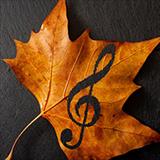
How to cite a single song or track reference
APA Style can help you cite the melodic works you love in your paper or manuscript. In this post, you will learn how to cite a single song or track reference.

The “outdated sources” myth
The “outdated sources” myth is that sources must have been published recently, such as the last 5 to 10 years. There is no timeliness requirement in APA Style.

Back-to-school resources for students of APA Style: 2021 edition
This post compiles instructional resources about APA Style for easy reference.

When and how to transliterate titles in references
APA Style guidelines are to transliterate the title of a work written in a non-Roman alphabet into the Roman alphabet in the reference list entry and if mentioning the title in the text of your paper.

How to cite translated works
In this blog post, you will learn how to cite translated works. When doing so, create the reference in the language in which the translation you read was published.

Why titles have sentence case capitalization in APA Style references
Why are article titles and book titles in APA Style references in sentence case? The answer takes us back to the 1929 origins of APA Style and a guideline that continues to have practical advantages today.
- Grades 6-12
- School Leaders
At ISTE? Join us at booth 1359!
How To Write a Bibliography (Plus Printable Guide With Examples)
Give credit where credit is due.
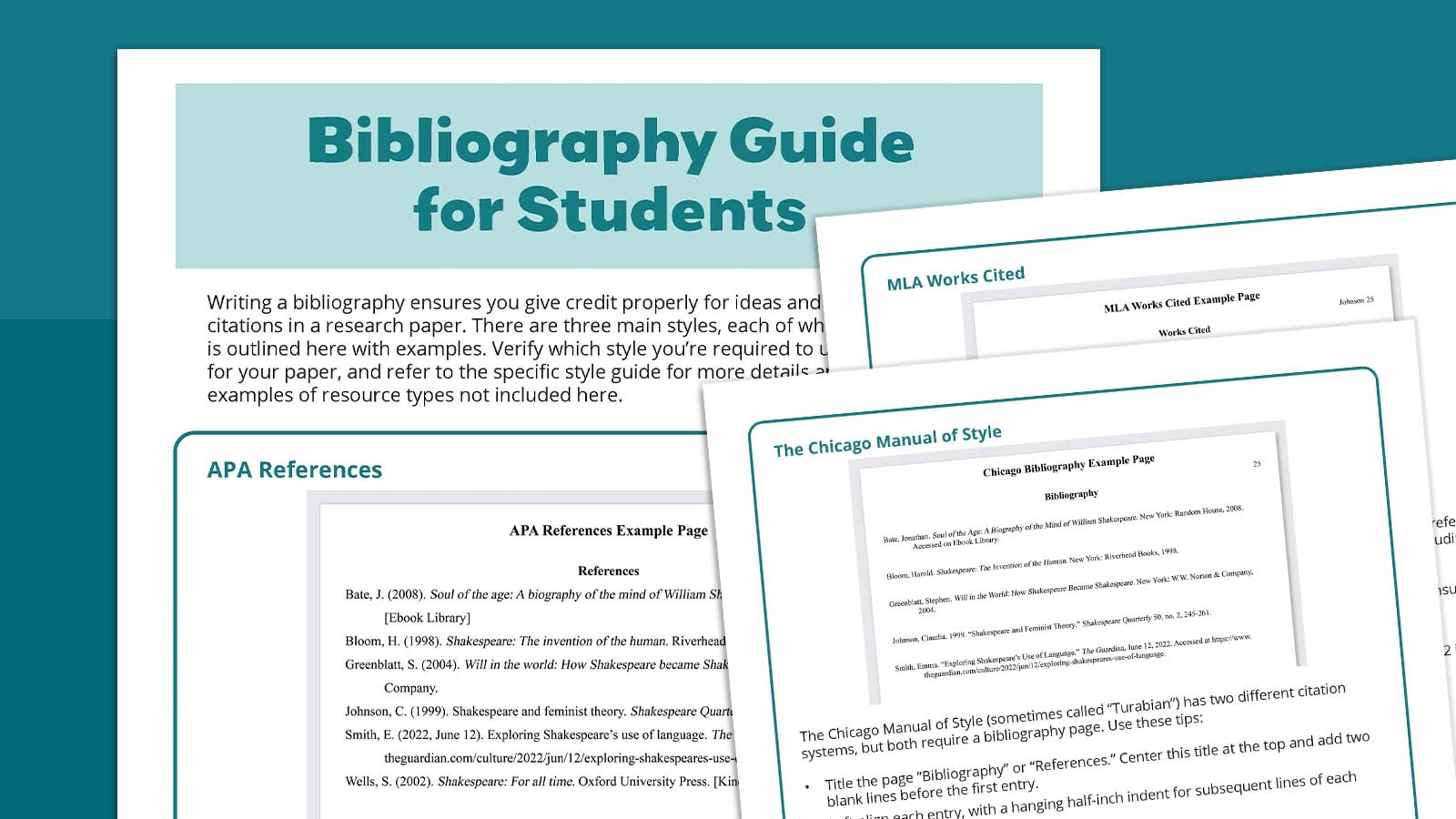
Writing a research paper involves a lot of work. Students need to consult a variety of sources to gather reliable information and ensure their points are well supported. Research papers include a bibliography, which can be a little tricky for students. Learn how to write a bibliography in multiple styles and find basic examples below.
Plus grab our printable Bibliography Guide for Students with examples from all three major style guides: APA (American Psychological Association), MLA (Modern Language Association), or The Chicago Manual of Style . Just fill out the form on this page to get the free guide.
IMPORTANT: Each style guide has its own very specific rules, and they often conflict with one another. Additionally, each type of reference material has many possible formats, depending on a variety of factors. The overviews shown here are meant to guide students in writing basic bibliographies, but this information is by no means complete. Students should always refer directly to the preferred style guide to ensure they’re using the most up-to-date formats and styles.
What is a bibliography?
When you’re researching a paper, you’ll likely consult a wide variety of sources. You may quote some of these directly in your work, summarize some of the points they make, or simply use them to further the knowledge you need to write your paper. Since these ideas are not your own, it’s vital to give credit to the authors who originally wrote them. This list of sources, organized alphabetically, is called a bibliography.
A bibliography should include all the materials you consulted in your research, even if you don’t quote directly from them in your paper. These resources could include (but aren’t limited to):
- Books and e-books
- Periodicals like magazines or newspapers
- Online articles or websites
- Primary source documents like letters or official records
Bibliography vs. References
These two terms are sometimes used interchangeably, but they actually have different meanings. As noted above, a bibliography includes all the materials you used while researching your paper, whether or not you quote from them or refer to them directly in your writing.
A list of references only includes the materials you cite throughout your work. You might use direct quotes or summarize the information for the reader. Either way, you must ensure you give credit to the original author or document. This section can be titled “List of Works Cited” or simply “References.”
Your teacher may specify whether you should include a bibliography or a reference list. If they don’t, consider choosing a bibliography to show all the works you used in researching your paper. This can help the reader see that your points are well supported and allow them to do further reading on their own if they’re interested.
Bibliography vs. Citations
Citations refer to direct quotations from a text that are woven into your own writing. There are a variety of ways to write citations, including footnotes and endnotes. These are generally shorter than the entries in a reference list or bibliography. Learn more about writing citations here.
What does a bibliography entry include?
Depending on the reference material, bibliography entries include a variety of information intended to help a reader locate the material if they want to refer to it themselves. These entries are listed in alphabetical order and may include:
- Author/s or creator/s
- Publication date
- Volume and issue numbers
- Publisher and publication city
- Website URL
These entries don’t generally need to include specific page numbers or locations within the work (except for print magazine or journal articles). That type of information is usually only needed in a footnote or endnote citation.
What are the different bibliography styles?
In most cases, writers use one of three major style guides: APA (American Psychological Association), MLA (Modern Language Association), or The Chicago Manual of Style . There are many others as well, but these three are the most common choices for K–12 students.
Many teachers will state their preference for one style guide over another. If they don’t, you can choose your own preferred style. However, you should also use that guide for your entire paper, following their recommendations for punctuation, grammar, and more. This will ensure you are consistent throughout.
Below, you’ll learn how to write a simple bibliography using each of the three major style guides. We’ve included details for books and e-books, periodicals, and electronic sources like websites and videos. If the reference material type you need to include isn’t shown here, refer directly to the style guide you’re using.
APA Style Bibliography and Examples
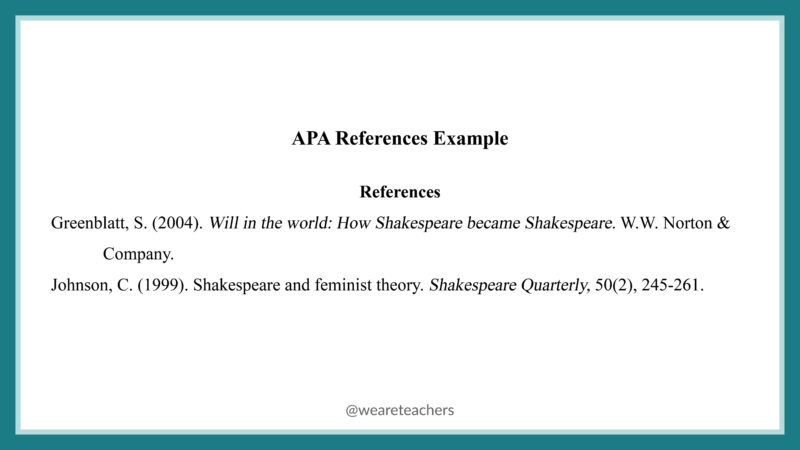
Technically, APA style calls for a list of references instead of a bibliography. If your teacher requires you to use the APA style guide , you can limit your reference list to only items you cite throughout your work.
How To Write a Bibliography (References) Using APA Style
Here are some general notes on writing an APA reference list:
- Title your bibliography section “References” and center the title on the top line of the page.
- Do not center your references; they should be left-aligned. For longer items, subsequent lines should use a hanging indent of 1/2 inch.
- Include all types of resources in the same list.
- Alphabetize your list by author or creator, last name first.
- Do not spell out the author/creator’s first or middle name—only use their initials.
- If there are multiple authors/creators, use an ampersand (&) before the final author/creator.
- Place the date in parentheses.
- Capitalize only the first word of the title and subtitle, unless the word would otherwise be capitalized (proper names, etc.).
- Italicize the titles of books, periodicals, and videos.
- For websites, include the full site information, including the http:// or https:// at the beginning.
Books and E-Books APA Bibliography Examples
For books, APA reference list entries use this format (only include the publisher’s website for e-books):
Last Name, First Initial. Middle Initial. (Publication date). Title with only first word capitalized (unless there’s a proper name/noun) . Publisher. Publisher’s website
- Wynn, S. (2020). City of London at war 1939–45 . Pen & Sword Military. https://www.pen-and-sword.co.uk/City-of-London-at-War-193945-Paperback/p/17299
Periodical APA Bibliography Examples
For journal or magazine articles, use the following format. If you viewed the article online, include the URL at the end of the citation.
Last Name, First Initial. Middle Initial. (Publication date). Title of article. Magazine or Journal Title (Volume number) Issue number, page numbers. URL
- Bell, A. (2009). Landscapes of fear: Wartime London, 1939–1945. Journal of British Studies (48) 1, 153–175. https://www.jstor.org/stable/25482966
Here’s the format for newspapers. For print editions, include the page number/s. For online articles, include the full URL:
Last Name, First Initial. Middle Initial. (Year, Month Date) Title of article. Newspaper title. Page number/s. URL
- Blakemore, E. (2022, November 12) Researchers track down two copies of fossil destroyed by the Nazis. The Washington Post. https://www.washingtonpost.com/science/2022/11/12/ichthyosaur-fossil-images-discovered/
Electronic APA Bibliography Examples
For articles with a specific author on a website, use this format:
Last Name, First Initial. Middle Initial. (Year, Month Date). Title . Site name. URL
- Wukovits, J. (2023, January 30). A World War II survivor recalls the London Blitz . British Heritage . https://britishheritage.com/history/world-war-ii-survivor-london-blitz
When an online article doesn’t include a specific author or date, list it like this:
Title . (Year, Month Date). Site name. Retrieved Month Date, Year, from URL
- Growing up in the Second World War . (n.d.). Imperial War Museums. Retrieved May 12, 2023, from https://www.iwm.org.uk/history/growing-up-in-the-second-world-war
When you need to list a YouTube video, use the name of the account that uploaded the video, and format it like this:
Name of Account. (Upload year, month day). Title [Video]. YouTube. URL
- War Stories. (2023, January 15). How did London survive the Blitz during WW2? Cities at war: London [Video]. YouTube. https://youtu.be/uwY6JlCvbxc
For more information on writing APA bibliographies, see the APA Style Guide website.
APA Bibliography (Reference List) Example Pages
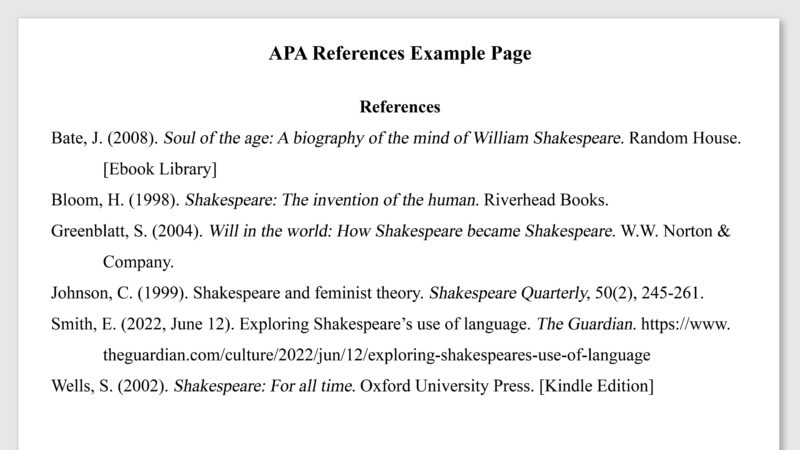
MLA Style Bibliography Examples
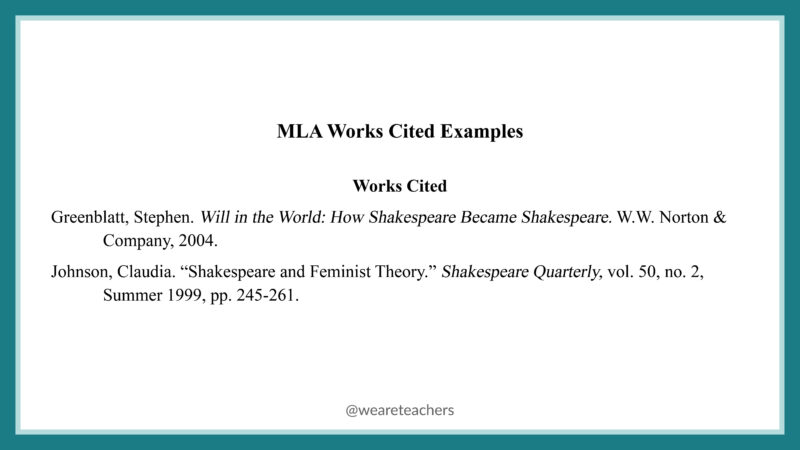
MLA style calls for a Works Cited section, which includes all materials quoted or referred to in your paper. You may also include a Works Consulted section, including other reference sources you reviewed but didn’t directly cite. Together, these constitute a bibliography. If your teacher requests an MLA Style Guide bibliography, ask if you should include Works Consulted as well as Works Cited.
How To Write a Bibliography (Works Cited and Works Consulted) in MLA Style
For both MLA Works Cited and Works Consulted sections, use these general guidelines:
- Start your Works Cited list on a new page. If you include a Works Consulted list, start that on its own new page after the Works Cited section.
- Center the title (Works Cited or Works Consulted) in the middle of the line at the top of the page.
- Align the start of each source to the left margin, and use a hanging indent (1/2 inch) for the following lines of each source.
- Alphabetize your sources using the first word of the citation, usually the author’s last name.
- Include the author’s full name as listed, last name first.
- Capitalize titles using the standard MLA format.
- Leave off the http:// or https:// at the beginning of a URL.
Books and E-Books MLA Bibliography Examples
For books, MLA reference list entries use the following format. Add the URL at the end for e-books.
Last Name, First Name Middle Name. Title . Publisher, Date. URL
- Wynn, Stephen. City of London at War 1939–45 . Pen & Sword Military, 2020. www.pen-and-sword.co.uk/City-of-London-at-War-193945-Paperback/p/17299
Periodical MLA Bibliography Examples
Here’s the MLA-style format for magazines, journals, and newspapers. For online articles, add the URL at the end of the listing:
For magazines and journals:
Last Name, First Name. “Title: Subtitle.” Name of Journal , volume number, issue number, Date of Publication, First Page Number–Last Page Number.
- Bell, Amy. “Landscapes of Fear: Wartime London, 1939–1945.” Journal of British Studies , vol. 48, no. 1, January 2009, pp. 153–175. www.jstor.org/stable/25482966
When citing newspapers, include the page number/s for print editions or the URL for online articles:
Last Name, First Name. “Title of article.” Newspaper title. Page number/s. Year, month day. Page number or URL
- Blakemore, Erin. “Researchers Track Down Two Copies of Fossil Destroyed by the Nazis.” The Washington Post. 2022, Nov. 12. www.washingtonpost.com/science/2022/11/12/ichthyosaur-fossil-images-discovered/
Electronic MLA Bibliography Examples
Last Name, First Name. Year. “Title.” Month Day, Year published. URL
- Wukovits, John. 2023. “A World War II Survivor Recalls the London Blitz.” January 30, 2023. https://britishheritage.com/history/world-war-ii-survivor-london-blitz
Website. n.d. “Title.” Accessed Day Month Year. URL.
- Imperial War Museum. n.d. “Growing Up in the Second World War.” Accessed May 9, 2023. www.iwm.org.uk/history/growing-up-in-the-second-world-war.
Here’s how to list YouTube and other online videos:
Creator, if available. “Title of Video.” Website. Uploaded by Username, Day Month Year. URL.
- “How did London survive the Blitz during WW2?” Cities at war: London | War stories.” YouTube . Uploaded by War Stories, 15 Jan. 2023. youtu.be/uwY6JlCvbxc.
For more information on writing MLA-style bibliographies, see the MLA Style website.
MLA Bibliography (Works Cited) Example Pages
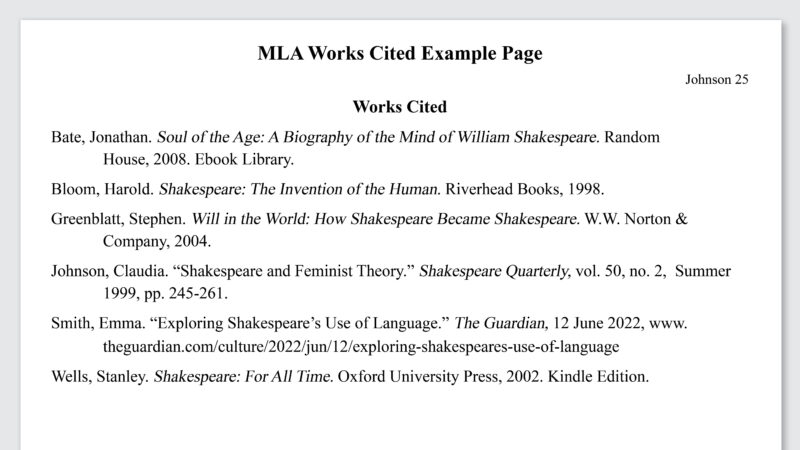
Chicago Manual of Style Bibliography Examples
The Chicago Manual of Style (sometimes called “Turabian”) actually has two options for citing reference material: Notes and Bibliography and Author-Date. Regardless of which you use, you’ll need a complete detailed list of reference items at the end of your paper. The examples below demonstrate how to write that list.
How To Write a Bibliography Using The Chicago Manual of Style
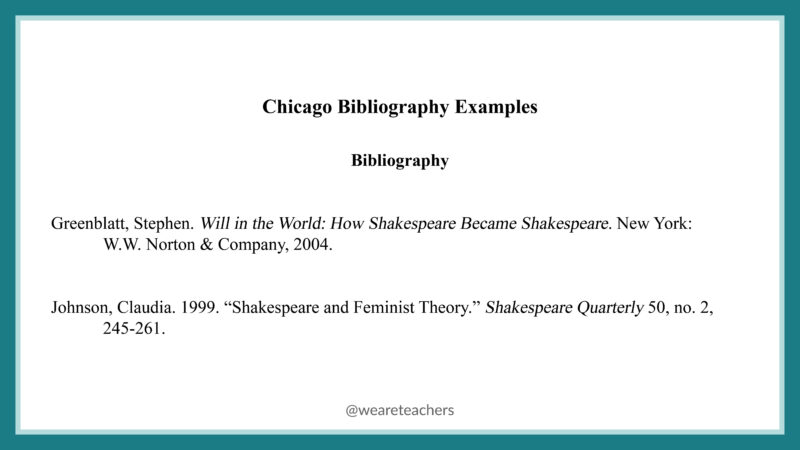
Here are some general notes on writing a Chicago -style bibliography:
- You may title it “Bibliography” or “References.” Center this title at the top of the page and add two blank lines before the first entry.
- Left-align each entry, with a hanging half-inch indent for subsequent lines of each entry.
- Single-space each entry, with a blank line between entries.
- Include the “http://” or “https://” at the beginning of URLs.
Books and E-Books Chicago Manual of Style Bibliography Examples
For books, Chicago -style reference list entries use the following format. (For print books, leave off the information about how the book was accessed.)
Last Name, First Name Middle Name. Title . City of Publication: Publisher, Date. How e-book was accessed.
- Wynn, Stephen. City of London at War 1939–45 . Yorkshire: Pen & Sword Military, 2020. Kindle edition.

Periodical Chicago Manual of Style Bibliography Examples
Here’s the style format for magazines, journals, and newspapers. For online articles, add the URL at the end of the listing.
For journal and magazine articles, use this format:
Last Name, First Name. Year of Publication. “Title: Subtitle.” Name of Journal , Volume Number, issue number, First Page Number–Last Page Number. URL.
- Bell, Amy. 2009. “Landscapes of Fear: Wartime London, 1939–1945.” Journal of British Studies, 48 no. 1, 153–175. https://www.jstor.org/stable/25482966.
When citing newspapers, include the URL for online articles:
Last Name, First Name. Year of Publication. “Title: Subtitle.” Name of Newspaper , Month day, year. URL.
- Blakemore, Erin. 2022. “Researchers Track Down Two Copies of Fossil Destroyed by the Nazis.” The Washington Post , November 12, 2022. https://www.washingtonpost.com/science/2022/11/12/ichthyosaur-fossil-images-discovered/.
Electronic Chicago Manual of Style Bibliography Examples
Last Name, First Name Middle Name. “Title.” Site Name . Year, Month Day. URL.
- Wukovits, John. “A World War II Survivor Recalls the London Blitz.” British Heritage. 2023, Jan. 30. britishheritage.com/history/world-war-ii-survivor-london-blitz.
“Title.” Site Name . URL. Accessed Month Day, Year.
- “Growing Up in the Second World War.” Imperial War Museums . www.iwm.org.uk/history/growing-up-in-the-second-world-war. Accessed May 9, 2023.
Creator or Username. “Title of Video.” Website video, length. Month Day, Year. URL.
- War Stories. “How Did London Survive the Blitz During WW2? | Cities at War: London | War Stories.” YouTube video, 51:25. January 15, 2023. https://youtu.be/uwY6JlCvbxc.
For more information on writing Chicago -style bibliographies, see the Chicago Manual of Style website.
Chicago Manual of Style Bibliography Example Pages
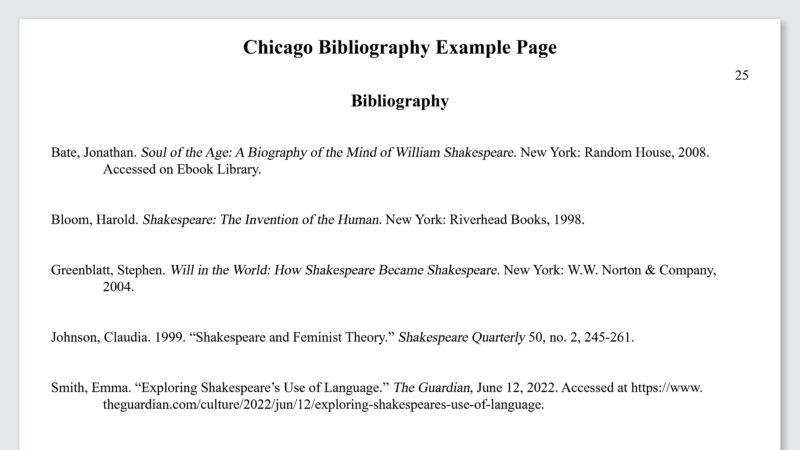
Get Your Free Printable Bibliography Style Guide
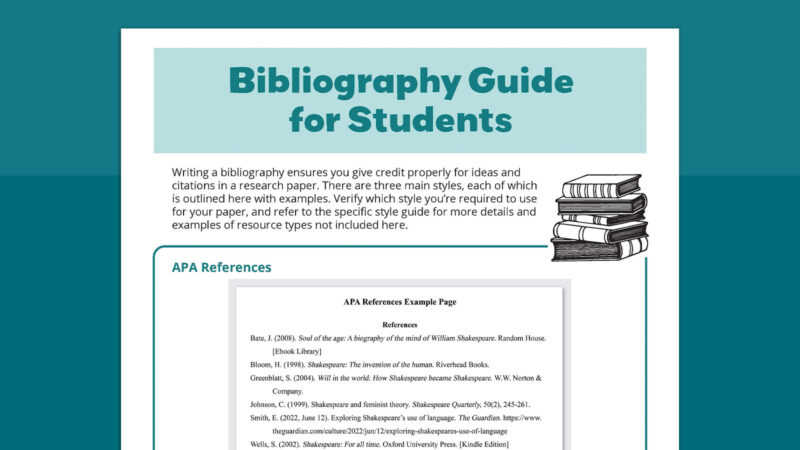
Just fill out the form on this page to grab our printable Bibliography Guide for Students with examples from all three major style guides: APA (American Psychological Association), MLA (Modern Language Association), or The Chicago Manual of Style .
Now that you know how to write a bibliography, take a look at the Best Websites for Teaching & Learning Writing .
Plus, get all the latest teaching tips and ideas when you sign up for our free newsletters , you might also like.
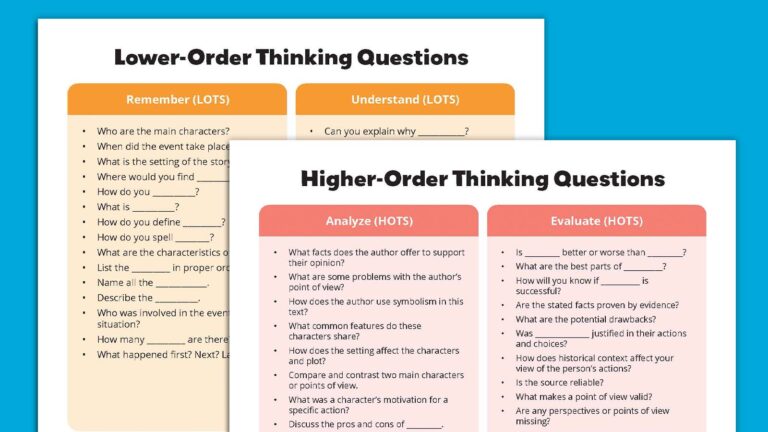
70 Higher-Order Thinking Questions To Challenge Your Students (Free Printable)
Plus 45 lower-order thinking questions too. Continue Reading
Copyright © 2024. All rights reserved. 5335 Gate Parkway, Jacksonville, FL 32256

In order to continue enjoying our site, we ask that you confirm your identity as a human. Thank you very much for your cooperation.
How to Write a Bibliography (MLA, APA Examples)

Learn how to easily write a bibliography by following the format outlined in this article.
This resource will help your students properly cite different resources in the bibliography of a research paper, and how to format those citations, for books, encyclopedias, films, websites, and people.
| Add to Folder | |
|---|---|
| creative writing | |
| children's book | |
| activities | |
| classroom tools | |
| language arts and writing | |
| vocabulary |
What is a bibliography?
According to Infoplease.com, A bibliography is a list of the types of sources you used to get information for your report. It is included at the end of your report, on the last page (or last few pages).
What are the types of bibliography styles (MLA, APA, etc.)?
The 3 most common bibliography/citation styles are:
- MLA Style: The Modern Language Association works cited page style
- APA Style: The American Psychological Association style
- Chicago Style: The bibliography style defined by the Chicago Manual of Style
We’ll give examples of how to create bibliography entries in various styles further down in this article.
What sources do you put in a bibliography?
An annotated bibliography should include a reference list of any sources you use in writing a research paper. Any printed sources from which you use a text citation, including books, websites, newspaper articles, journal articles, academic writing, online sources (such as PDFs), and magazines should be included in a reference list. In some cases, you may need or want to cite conversations or interviews, works of art, visual works such as movies, television shows, or documentaries - these (and many others) can also be included in a reference list.
How to get started writing your bibliography
You will find it easier to prepare your MLA, APA, or Chicago annotated bibliography if you keep track of each book, encyclopedia, journal article, webpage or online source you use as you are reading and taking notes. Start a preliminary, or draft, bibliography by listing on a separate sheet of paper all your sources. Note down the full title, author’s last name, place of publication, web address, publisher, and date of publication for each source.
Haven't started your paper yet and need an outline? These sample essay outlines include a research paper outline from an actual student paper.
How to write a bibliography step-by-step (with examples)
General Format: Author (last name first). Title of the book. Publisher, Date of publication.
MLA Style: Sibley, David Allen. What It’s Like to Be a Bird. From Flying to Nesting, Eating to Singing, What Birds Are Doing, and Why. Alfred A. Knopf, 2020.
APA Style: Sibley, D.A. (2020). What It’s Like to Be a Bird. From Flying to Nesting, Eating to Singing, What Birds Are Doing, and Why . Alfred A. Knopf.
Notes: Use periods, not commas, to separate the data in the entry. Use a hanging indent if the entry is longer than one line. For APA style, do not use the full author’s first name.
Websites or webpages:
MLA Style: The SB Nation Family of Sites. Pension Plan Puppets: A Toronto Maple Leafs Blog, 2022, www.pensionplanpuppets.com. Accessed 15 Feb. 2022.
APA Style: American Heart Association. (2022, April 11). How to keep your dog’s heart healthy. https://www.heart.org/en/news/2022/04/11/how-to-keep-your-dogs-heart-healthy
Online news article from a newspaper site:
APA Style: Duehren, A. (2022, April 9). Janet Yellen faces challenge to keep pressure on Russia. Wall Street Journal. https://www.wsj.com/articles/janet-yellen-faces-challenge-to-keep-pressure-on-russia-while-addressing-global-consequences-11650366000
Print journal articles:
MLA Style: Booch, Grady. "Patterns in Object-Oriented Design." IEEE Software Engineering, vol. 6, no. 6, 2006, pp. 31-50.
APA Style: Booch, G. (2006). Patterns in object-oriented design. IEEE Software Engineering, 6(6), 31–50.
Note: It is suggested that you include a DOI and a webpage address when referencing either a printed journal article, and electronic journal article, or an journal article that appears in both formats.
MLA Style: Gamma, Eric, and Peter A. Coad. “Exceptions to the Unified Modeling Language in Python Patterns.” IEEE Software Engineering, vol. 2, no. 6, 8 Mar. 2006, pp. 190-194. O’Reilly Software Engineering Library, https://doi.org/10.1006/se.20061. Accessed 26 May 2009.
APA Style: Masters, H., Barron, J., & Chanda, L. (2017). Motivational interviewing techniques for adolescent populations in substance abuse counseling. NAADAC Notes, 7(8), 7–13. https://www.naadac.com/notes/adolescent-techniques
ML:A Style: @Grady_Booch. “That’s a bold leap over plain old battery power cars.” Twitter, 13 Mar. 2013, 12:06 p.m., https://twitter.com/Grady_Booch/status/1516379006727188483.
APA Style: Westborough Library [@WestboroughLib]. (2022, April 12). Calling all 3rd through 5th grade kids! Join us for the Epic Writing Showdown! Winner receives a prize! Space is limited so register, today. loom.ly/ypaTG9Q [Tweet; thumbnail link to article]. Twitter. https://twitter.com/WestboroughLib/status/1516373550415896588.
Print magazine articles:
General format: Author (last name first), "Article Title." Name of magazine. Volume number, (Date): page numbers.
MLA Style: Stiteler, Sharon. "Tracking Red-Breasted Grosbeak Migration." Minnesota Bird Journal, 7 Sept. 2019, pp. 7-11.
APA Style: Jordan, Jennifer, "Filming at the Top of the World." Museum of Science Magazine. Volume 47, No. 1, (Winter 1998): p. 11.
Print newspaper articles:
General format: Author (last name first), "Article Title." Name of newspaper, city, state of publication. (date): edition if available, section, page number(s).
MLA Style: Adelman, Martin. "Augustus Announces Departure from City Manager Post." New York Times, late ed., 15 February 2020, p. A1
APA Style: Adelman, M. (2020, February 15). Augustus announced departure from city manager post. New York Times, A1.
Encyclopedias:
General Format: Encyclopedia Title, Edition Date. Volume Number, "Article Title," page numbers.
MLA Style: “Gorillas.” The Encyclopedia Brittanica. 15th ed. 2010.
APA Style: Encyclopedia Brittanica, Inc. (1997.) Gorillas. In The Encyclopedia Brittanica (15th ed., pp. 50-51). Encyclopedia Brittanica, Inc.
Personal interviews:
General format: Full name (last name first). Personal Interview. (Occupation.) Date of interview.
MLA Style: Smithfield, Joseph. Personal interview. 19 May 2014.
APA Style: APA does not require a formal citation for a personal interview. Published interviews from other sources should be cited accordingly.
Films and movies:
General format: Title, Director, Distributor, Year.
MLA Style: Fury. Directed by David Ayer, performances by Brad Pitt, Shia LaBeouf, Jon Bernthal, Sony Pictures, 2014.
APA Style: Ayer, D. (Director). (2014). Fury [Film]. Sony Pictures.
Featured High School Resources

Related Resources

About the author

TeacherVision Editorial Staff
The TeacherVision editorial team is comprised of teachers, experts, and content professionals dedicated to bringing you the most accurate and relevant information in the teaching space.


Generate formatted bibliographies, citations, and works cited automatically
What is mybib.
MyBib is a free bibliography and citation generator that makes accurate citations for you to copy straight into your academic assignments and papers.
If you're a student, academic, or teacher, and you're tired of the other bibliography and citation tools out there, then you're going to love MyBib. MyBib creates accurate citations automatically for books, journals, websites, and videos just by searching for a title or identifier (such as a URL or ISBN).
Plus, we're using the same citation formatting engine as professional-grade reference managers such as Zotero and Mendeley, so you can be sure our bibliographies are perfectly accurate in over 9,000 styles -- including APA 6 & 7, Chicago, Harvard, and MLA 7 & 8.
Quick features:
| ⚙️ Styles | APA, MLA, Harvard |
|---|---|
| 📚 Sources | Websites, books, journals, newspapers |
| 🔎 Autocite | Yes |
| 📥 Download to | Microsoft Word, Google Docs |

How to Write a Research Paper: Annotated Bibliography
- Anatomy of a Research Paper
- Developing a Research Focus
- Background Research Tips
- Searching Tips
- Scholarly Journals vs. Popular Journals
- Thesis Statement
- Annotated Bibliography
- Citing Sources
- Evaluating Sources
- Literature Review
- Academic Integrity
- Scholarship as Conversation
- Understanding Fake News
- Data, Information, Knowledge
What is an Annotated Bibliography?
UMary Writing Center

Check out the resources available from the Writing Center .
Write an Annotated Bibliography
What is an annotated bibliography?
It is a list of citations for various books, articles, and other sources on a topic.
An annotation is a short summary and/or critical evaluation of a source.
Annotated bibliographies answer the question: "What would be the most relevant, most useful, or most up-to-date sources for this topic?"
Annotated bibliographies can be part of a larger research project, or can be a stand-alone report in itself.
Annotation versus abstracts
An abstract is a paragraph at the beginning of the paper that discusses the main point of the original work. They typically do not include evaluation comments.
Annotations can either be descriptive or evaluative. The annotated bibliography looks like a works cited page but includes an annotation after each source cited.
Types of Annotations:
Descriptive Annotations: Focuses on description. Describes the source by answering the following questions.
Who wrote the document?
What does the document discuss?
When and where was the document written?
Why was the document produced?
How was it provided to the public?
Evaluative Annotations: Focuses on description and evaluation. Includes a summary and critically assess the work for accuracy, relevance, and quality.
Evaluative annotations help you learn about your topic, develop a thesis statement, decide if a specific source will be useful for your assignment, and determine if there is enough valid information available to complete your project.
What does the annotation include?
Depending on your assignment and style guide, annotations may include some or all of the following information.
- Should be no more than 150 words or 4 to 6 sentences long.
- What is the main focus or purpose of the work?
- Who is the intended audience?
- How useful or relevant was the article to your topic?
- Was there any unique features that useful to you?
- What is the background and credibility of the author?
- What are any conclusions or observations that your reached about the article?
Which citation style to use?
There are many styles manuals with specific instructions on how to format your annotated bibliography. This largely depends on what your instructor prefers or your subject discipline. Check out our citation guides for more information.
Additional Information
Why doesn't APA have an official APA-approved format for annotated bibliographies?
Always consult your instructor about the format of an annotated bibliography for your class assignments. These guides provide you with examples of various styles for annotated bibliographies and they may not be in the format required by your instructor.
Citation Examples and Annotations
Book Citation with Descriptive Annotation
Liroff, R. A., & G. G. Davis. (1981). Protecting open space: Land use control in the Adirondack Park. Cambridge, MA: Ballinger.
This book describes the implementation of regional planning and land use regulation in the Adirondack Park in upstate New York. The authors provide program evaluations of the Adirondack Park Agencys regulatory and local planning assistance programs.
Journal Article Citation with Evaluative Annotation
Gottlieb, P. D. (1995). The “golden egg” as a natural resource: Toward a normative theory of growth management. Society and Natural Resources, 8, (5): 49-56.
This article explains the dilemma faced by North American suburbs, which demand both preservation of local amenities (to protect quality of life) and physical development (to expand the tax base). Growth management has been proposed as a policy solution to this dilemma. An analogy is made between this approach and resource economics. The author concludes that the growth management debate raises legitimate issues of sustainability and efficiency.
Examples were taken from http://lib.calpoly.edu/support/how-to/write-an-annotated-bibliography/#samples
Book Citation
Lee, Seok-hoon, Yong-pil Kim, Nigel Hemmington, and Deok-kyun Yun. “Competitive Service Quality Improvement (CSQI): A Case Study in the Fast-Food Industry.” Food Service Technology 4 (2004): 75-84.
In this highly technical paper, three industrial engineering professors in Korea and one services management professor in the UK discuss the mathematical limitations of the popular SERVQUAL scales. Significantly, they also aim to measure service quality in the fast-food industry, a neglected area of study. Unfortunately, the paper’s sophisticated analytical methods make it inaccessible to all but the most expert of researchers.
Battle, Ken. “Child Poverty: The Evolution and Impact of Child Benefits.” A Question of Commitment: Children's Rights in Canada . Ed. Katherine Covell and R.Brian Howe. Waterloo, ON: Wilfrid Laurier University Press. 2007. 21-44.
Ken Battle draws on a close study of government documents, as well as his own research as an extensively-published policy analyst, to explain Canadian child benefit programs. He outlines some fundamental assumptions supporting the belief that all society members should contribute to the upbringing of children. His comparison of child poverty rates in a number of countries is a useful wake-up to anyone assuming Canadian society is doing a good job of protecting children. Battle pays particular attention to the National Child Benefit (NCB), arguing that it did not deserve to be criticized by politicians and journalists. He outlines the NCB’s development, costs, and benefits, and laments that the Conservative government scaled it back in favour of the inferior Universal Child Care Benefit (UCCB). However, he relies too heavily on his own work; he is the sole or primary author of almost half the sources in his bibliography. He could make this work stronger by drawing from others' perspectives and analyses. However, Battle does offer a valuable source for this essay, because the chapter provides a concise overview of government-funded assistance currently available to parents. This offers context for analyzing the scope and financial reality of child poverty in Canada.
Journal Article Example
Kerr, Don and Roderic Beaujot. “Child Poverty and Family Structure in Canada, 1981-1997.” Journal of Comparative Family Studies 34.3 (2003): 321-335.
Sociology professors Kerr and Beaujot analyze the demographics of impoverished families. Drawing on data from Canada’s annual Survey of Consumer Finances, the authors consider whether each family had one or two parents, the age of single parents, and the number of children in each household. They analyze child poverty rates in light of both these demographic factors and larger economic issues. Kerr and Beaujot use this data to argue that.
Examples were taken from http://libguides.enc.edu/writing_basics/ annotatedbib/mla
Check out these resources for more information about Annotated Bibliographies.
- Purdue Owl- Annotated Bibliographies
- University of North Carolina at Chapel Hill- Annotated Bibliographies
- << Previous: Thesis Statement
- Next: Citing Sources >>
- Last Updated: Apr 4, 2024 5:51 PM
- URL: https://libguide.umary.edu/researchpaper

authorsafterdark.org
research paper writing tips from the top experts

How to Write a Bibliography for a Research Paper: Guide & Samples
A bibliography is undoubtedly one of the most essential parts of every research paper. A research paper without a bibliography equals poorly conducted research. As such, the importance of a bibliography in a research paper cannot be overemphasized.
To produce well-constructed research, you must consult other authors and use their materials to support your argument. This is the only way to give these authors their credit; by listing them out in your bibliography.
Acknowledging the sources used in writing the topic is an effective approach to avoiding plagiarism in your research. It is also a great way to provide and inform other scholars with sources they may not be aware of. This article seeks to provide the format of bibliography and how to write a good bibliography for your research paper.
What Is a Bibliography in a Research Paper?
Simply put, a bibliography is a list of works used in writing a research paper. Every research paper must contain a list of sources the author used in preparing the research paper. Your source can range from books to scholarly papers, speeches, private records, interviews, letters, websites, and other sources.
Your research paper was not created in a vacuum; you must have consulted other authors or sourced to create enriched content. Therefore, at the end of your research, you must attach a list of all the sources used.
How to Write Bibliography for Research Paper
Writing a bibliography isn’t so hard; all you need is a list of sources used and a format for documenting them. To make things easier for you, prepare a draft comprising all of the sources you must have used. Ensure you include the book’s full title, the author, place of publication, publication date, and publisher. All sources must be listed out alphabetically using the authors’ names.
It is also important to note that there are different formats for writing a bibliography. As such, you must decide which format to employ in your research paper. You can format your work in Modern Language Association (MLA) format, American Psychological Association (APA), or Chicago Manual of Style (CMS). Regardless of which you choose, ensure that it is done correctly.
How to Format a Bibliography
Once you have an idea of how to format a bibliography, most of the work is completed. However, when writing it you need to pay close attention to each format and its content to avoid mixing them up. For printed sources, the bibliography of a research paper should provide the following:
- Author’s name
- Title of publication (provide the title of the article if it’s a journal, magazine, or encyclopedia)
- Date of publication
- Place of Publication of a book
- The publishing house of a book
- Volume number of magazine or encyclopedia
- The page numbers
To document sources from a website, you need to document the following:
- The author or editor’s name if there’s any
- Title of the page
- The organization of the webpage
- The URL of the website
- The date the information was gotten from the website
The common formats for writing a bibliography in a research paper are MLA and APA style. A bibliography is known as “Works Cited” in MLA and on the other hand, it is called “References List” in APA. Though both formats contain similar information about the sources used, there are still slight differences in formatting style. Here’s what MLA and APA bibliography styles should look like.
How to Write a Bibliography APA
Your research paper’s bibliography must be attached at the end of it with the tag “References” at the center. In addition to this, you need to pay attention to the basics of APA style, such as capitalization, abbreviation, punctuation, underlining or italics, hanging indentation, and others. Here’s a research paper bibliography example in APA style:
Author’s last name, first initial. (Publication date). Book title . City of Publication: Publishing company.
- For encyclopedia:
Author’s last name, first initial. (Date). Title of Article. Title of Encyclopedia (Volumes, pages). City of Publication: Publishing Company.
- For magazine and newspaper articles:
Author’s last name, first initial. (Publication Date). Article title. Periodical title, Volume number (issue number if there’s any), page numbers.
How to Write a Bibliography MLA
Bibliography in MLA format is called “Works cited” and must be arranged in alphabetical order according to the author’s name. Here’s the required format for MLA style for varying sources:
“Author’s last name, first name. Book title. Publication City: Publishing company, publication date.”
- Encyclopedia & dictionary:
“Author’s last name, first name. “Title of Article.” Encyclopedia’s Title. Date.”
- Magazine & newspaper:
“Author’s last name, first name. “Article title.” Periodical title volume Date: inclusive pages.”

Leave a Reply Cancel reply
Your email address will not be published. Required fields are marked *
Scribbr Citation Generator
Accurate APA, MLA, Chicago, and Harvard citations, verified by experts, trusted by millions

Scribbr for Chrome: Your shortcut to citations
Cite any page or article with a single click right from your browser. The extension does the hard work for you by automatically grabbing the title, author(s), publication date, and everything else needed to whip up the perfect citation.
| ⚙️ Styles | APA, MLA, Chicago, Harvard |
|---|---|
| 📚 Source types | Websites, books, articles |
| 🔎 Autocite | Search by title, URL, DOI, or ISBN |

Perfectly formatted references every time
Inaccurate citations can cost you points on your assignments, so our seasoned citation experts have invested countless hours in perfecting Scribbr’s citation generator algorithms. We’re proud to be recommended by teachers and universities worldwide.
Enjoy a citation generator without flashy ads
Staying focused is already difficult enough, so unlike other citation generators, Scribbr won’t slow you down with flashing banner ads and video pop-ups. That’s a promise!
Citation Generator features you'll love
Look up your source by its title, URL, ISBN, or DOI, and let Scribbr find and fill in all the relevant information automatically.
APA, MLA, Chicago, and Harvard
Generate flawless citations according to the official APA, MLA, Chicago, Harvard style, or many other rules.
Export to Word
When your reference list is complete, export it to Word. We’ll apply the official formatting guidelines automatically.
Lists and folders
Create separate reference lists for each of your assignments to stay organized. You can also group related lists into folders.
Export to Bib(La)TeX
Are you using a LaTex editor like Overleaf? If so, you can easily export your references in Bib(La)TeX format with a single click.
Custom fonts
Change the typeface used for your reference list to match the rest of your document. Options include Times New Roman, Arial, and Calibri.
Industry-standard technology
Scribbr’s Citation Generator is built using the same citation software (CSL) as Mendeley and Zotero, but with an added layer for improved accuracy.
Annotations
Describe or evaluate your sources in annotations, and Scribbr will generate a perfectly formatted annotated bibliography .
Citation guides
Scribbr’s popular guides and videos will help you understand everything related to finding, evaluating, and citing sources.
Secure backup
Your work is saved automatically after every change and stored securely in your Scribbr account.
- Introduction
- Finding sources
Evaluating sources
- Integrating sources
Citing sources
Tools and resources, a quick guide to working with sources.
Working with sources is an important skill that you’ll need throughout your academic career.
It includes knowing how to find relevant sources, assessing their authority and credibility, and understanding how to integrate sources into your work with proper referencing.
This quick guide will help you get started!
Finding relevant sources
Sources commonly used in academic writing include academic journals, scholarly books, websites, newspapers, and encyclopedias. There are three main places to look for such sources:
- Research databases: Databases can be general or subject-specific. To get started, check out this list of databases by academic discipline . Another good starting point is Google Scholar .
- Your institution’s library: Use your library’s database to narrow down your search using keywords to find relevant articles, books, and newspapers matching your topic.
- Other online resources: Consult popular online sources like websites, blogs, or Wikipedia to find background information. Be sure to carefully evaluate the credibility of those online sources.
When using academic databases or search engines, you can use Boolean operators to refine your results.
Generate APA, MLA, Chicago, and Harvard citations in seconds
Get started
In academic writing, your sources should be credible, up to date, and relevant to your research topic. Useful approaches to evaluating sources include the CRAAP test and lateral reading.
CRAAP is an abbreviation that reminds you of a set of questions to ask yourself when evaluating information.
- Currency: Does the source reflect recent research?
- Relevance: Is the source related to your research topic?
- Authority: Is it a respected publication? Is the author an expert in their field?
- Accuracy: Does the source support its arguments and conclusions with evidence?
- Purpose: What is the author’s intention?
Lateral reading
Lateral reading means comparing your source to other sources. This allows you to:
- Verify evidence
- Contextualize information
- Find potential weaknesses
If a source is using methods or drawing conclusions that are incompatible with other research in its field, it may not be reliable.
Integrating sources into your work
Once you have found information that you want to include in your paper, signal phrases can help you to introduce it. Here are a few examples:
| Function | Example sentence | Signal words and phrases |
|---|---|---|
| You present the author’s position neutrally, without any special emphasis. | recent research, food services are responsible for one-third of anthropogenic greenhouse gas emissions. | According to, analyzes, asks, describes, discusses, explains, in the words of, notes, observes, points out, reports, writes |
| A position is taken in agreement with what came before. | Recent research Einstein’s theory of general relativity by observing light from behind a black hole. | Agrees, confirms, endorses, reinforces, promotes, supports |
| A position is taken for or against something, with the implication that the debate is ongoing. | Allen Ginsberg artistic revision … | Argues, contends, denies, insists, maintains |
Following the signal phrase, you can choose to quote, paraphrase or summarize the source.
- Quoting : This means including the exact words of another source in your paper. The quoted text must be enclosed in quotation marks or (for longer quotes) presented as a block quote . Quote a source when the meaning is difficult to convey in different words or when you want to analyze the language itself.
- Paraphrasing : This means putting another person’s ideas into your own words. It allows you to integrate sources more smoothly into your text, maintaining a consistent voice. It also shows that you have understood the meaning of the source.
- Summarizing : This means giving an overview of the essential points of a source. Summaries should be much shorter than the original text. You should describe the key points in your own words and not quote from the original text.
Whenever you quote, paraphrase, or summarize a source, you must include a citation crediting the original author.
Citing your sources is important because it:
- Allows you to avoid plagiarism
- Establishes the credentials of your sources
- Backs up your arguments with evidence
- Allows your reader to verify the legitimacy of your conclusions
The most common citation styles are APA, MLA, and Chicago style. Each citation style has specific rules for formatting citations.
Generate APA, MLA, Chicago, and Harvard citations in seconds
Scribbr offers tons of tools and resources to make working with sources easier and faster. Take a look at our top picks:
- Citation Generator: Automatically generate accurate references and in-text citations using Scribbr’s APA Citation Generator, MLA Citation Generator , Harvard Referencing Generator , and Chicago Citation Generator .
- Plagiarism Checker : Detect plagiarism in your paper using the most accurate Turnitin-powered plagiarism software available to students.
- AI Proofreader: Upload and improve unlimited documents and earn higher grades on your assignments. Try it for free!
- Paraphrasing tool: Avoid accidental plagiarism and make your text sound better.
- Grammar checker : Eliminate pesky spelling and grammar mistakes.
- Summarizer: Read more in less time. Distill lengthy and complex texts down to their key points.
- AI detector: Find out if your text was written with ChatGPT or any other AI writing tool. ChatGPT 2 & ChatGPT 3 supported.
- Proofreading services : Have a human editor improve your writing.
- Citation checker: Check your work for citation errors and missing citations.
- Knowledge Base : Explore hundreds of articles, bite-sized videos, time-saving templates, and handy checklists that guide you through the process of research, writing, and citation.

IMAGES
VIDEO
COMMENTS
Bibliography Entry for a Book. A bibliography entry for a book begins with the author's name, which is written in this order: last name, comma, first name, period. After the author's name comes the title of the book. If you are handwriting your bibliography, underline each title. If you are working on a computer, put the book title in ...
A bibliography in research paper is a list of sources that appears at the end of a research paper or an article, and contains information that may or may not be directly mentioned in the research paper. The difference between reference and bibliography in research is that an individual source in the list of references can be linked to an in ...
Step 1: Create a Preliminary Bibliography. While you are doing your research and gathering data for your research paper, it can be helpful to create preliminary bibliography. Not only will this take the work out for you in the end, but it can help you to organize your thoughts as well.
An APA format bibliography is an alphabetical listing of all sources that might be used to write an academic paper, essay, article, or research paper—particularly work that is covering psychology or psychology-related topics. APA format is the official style of the American Psychological Association (APA). This format is used by many ...
Formatting a Harvard style bibliography. Sources are alphabetised by author last name. The heading 'Reference list' or 'Bibliography' appears at the top. Each new source appears on a new line, and when an entry for a single source extends onto a second line, a hanging indent is used: Harvard bibliography example.
APA 7 style guidelines require a reference list of all the sources you included in your research paper. APA references follow the author-date style of citation. You may be asked to create an annotated APA bibliography, however. This could be a separate assignment or part of the larger research project.
Examples of Bibliography Format Examples of Bibliography Formats. There are standards for documenting sources of information in research papers. Even though different journals may use a slightly different format for the bibliography, they all contain the same basic information.
Bibliography. If you are using Chicago style footnotes or endnotes, you should include a bibliography at the end of your paper that provides complete citation information for all of the sources you cite in your paper. Bibliography entries are formatted differently from notes. For bibliography entries, you list the sources alphabetically by last ...
A bibliography is a list of works on a subject or by an author that were used or consulted to write a research paper, book or article. It can also be referred to as a list of works cited. It is usually found at the end of a book, article or research paper. Gathering Information. Regardless of what citation style is being used, there are key ...
Research paper Academic writing Starting the research process ... Citation styles also differ in terms of how you format the reference list or bibliography entries themselves (e.g., capitalization, order of information, use of italics). And many style guides also provide guidance on more general issues like text formatting, punctuation, and ...
A reference list contains works that specifically support the ideas, claims, and concepts in a paper; in contrast, a bibliography provides works for background or further reading and may include descriptive notes (e.g., an annotated bibliography). The Publication Manual (see Section 9.51) provides formatting guidance and examples for annotated ...
Writing a research paper involves a lot of work. Students need to consult a variety of sources to gather reliable information and ensure their points are well supported. Research papers include a bibliography, which can be a little tricky for students. Learn how to write a bibliography in multiple styles and find basic examples below.
A bibliography is a detailed list of all the sources consulted and cited in a research paper or project. The bibliography structure always includes citing the author's name, the title of the work ...
An annotated bibliography should include a reference list of any sources you use in writing a research paper. Any printed sources from which you use a text citation, including books, websites, newspaper articles, journal articles, academic writing, online sources (such as PDFs), and magazines should be included in a reference list.
The main guidelines for formatting a paper in APA Style are as follows: Use a standard font like 12 pt Times New Roman or 11 pt Arial. Set 1 inch page margins. Apply double line spacing. If submitting for publication, insert a APA running head on every page. Indent every new paragraph ½ inch.
An annotated bibliography is a list of source references that includes a short descriptive text (an annotation) for each source. It may be assigned as part of the research process for a paper, or as an individual assignment to gather and read relevant sources on a topic. Scribbr's free Citation Generator allows you to easily create and manage ...
MyBib is a free bibliography and citation generator that makes accurate citations for you to copy straight into your academic assignments and papers. If you're a student, academic, or teacher, and you're tired of the other bibliography and citation tools out there, then you're going to love MyBib. MyBib creates accurate citations automatically ...
Annotated bibliographies can be part of a larger research project, or can be a stand-alone report in itself. Annotation versus abstracts. An abstract is a paragraph at the beginning of the paper that discusses the main point of the original work. They typically do not include evaluation comments. Annotations can either be descriptive or evaluative.
Cite anything. ZoteroBib helps you build a bibliography instantly from any computer or device, without creating an account or installing any software. It's brought to you by the team behind Zotero, the powerful open-source research tool recommended by thousands of universities worldwide, so you can trust it to help you seamlessly add sources ...
The common formats for writing a bibliography in a research paper are MLA and APA style. A bibliography is known as "Works Cited" in MLA and on the other hand, it is called "References List" in APA. Though both formats contain similar information about the sources used, there are still slight differences in formatting style.
Writing up research, or its oral presentation, is a 'site of contestation' (Lewis-Beck et al., 2004: 1197), one which can be regarded as problem solving with its own subprocesses and mental events (Flower and Hayes, 1981; Kellogg, 1994). (b) Conventional humanities' format (citations in the notes)
Citation Generator: Automatically generate accurate references and in-text citations using Scribbr's APA Citation Generator, MLA Citation Generator, Harvard Referencing Generator, and Chicago Citation Generator. Plagiarism Checker: Detect plagiarism in your paper using the most accurate Turnitin-powered plagiarism software available to students.